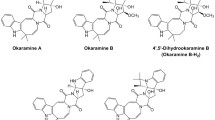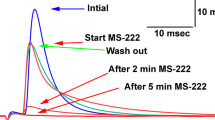Summary
-
1.
l-α, ω-diamino acids and their derivatives facilitate the chemically induced settlement and metamorphosis of larvae ofHaliotis rufescens, a marine gastropod.
-
2.
Organic inducers of settlement and metamorphosis used in this study include γ-aminobutyric acid (GABA), muscimol, and the macromolecular fraction of a cell-free extract of the naturally recruiting crustose red alga,Lithothamnium californicum. An inorganic inducer of settlement and metamorphosis, ionic potassium, is also used.
-
3.
When the inducing compound is GABA, muscimol, or a macromolecular component ofL. californicum, the presence of a diamino acid facilitator converts a sigmoid concentration-response curve to a hyperbolic one, and shifts the curve to the left (Figs. 1, 3 and 4). The Hill coefficient in the absence of facilitator reveals significant positive cooperativity for induction by GABA; increasing concentration of facilitator progressively lowers the Hill coefficient (Fig. 2). When induction is activated directly by ionic potassium (Fig. 5), facilitators have significantly less effect.
-
4.
A number ofl-α, ω-diamino acids (includingl-α, β-diaminopropionic acid (l-DAPA),l-α, γ-diaminobutyric acid (l-DABA),l-ornithine, andl-lysine) all facilitate the induction of larval settlement and metamorphosis at micromolar concentrations (Fig. 6). Of a number of other amino acids and their derivatives tested, only thel-lysine derivatives poly-l-lysine andl-(−)-α-amino-ε-caprolactam are active as facilitators. Facilitatory activity is dependent on both of the amino groups, and the carboxyl group, of the diamino acids (Table 1); thel-stereochemical configuration also is essential for this activity (Fig. 7).
-
5.
The benzodiazepines flurazepam, diazepam, and flunitrazepam, facilitators of GABA binding in certain mammalian GABAergic neurons, do not facilitate induction of larval settlement and metamorphosis by GABA.
-
6.
The diamino acidl-lysine does not facilitate induction by substances that can not themselves induce settlement (Figs. 8, 9).
-
7.
Allosteric regulation of chemosensory receptors controlling larval metamorphosis is suggested by the results of this study.
Similar content being viewed by others
References
Baloun AJ, Morse DE (1984) Ionic control of settlement and metamorphosis in larvalHaliotis rufescens (Gastropoda). Biol Bull 167:124–138
Barbeau A, Tsukuda Y, Inoue I (1976) Neuropharmacology of taurine. In: Huxtable R, Barbeau A (eds) Taurine. Raven Press, New York, pp 253–263
Birkeland C (1982) Terrestrial runoff as a cause of outbreaks ofAcanthaster planci (Echinodermata: Asteroidea). Mar Biol 69:175–185
Bradford HF, Davison AN, Wheler GHT (1976) Taurine and synaptic transmission. In: Huxtable R, Barbeau A (eds) Taurine. Raven Press, New York, pp 303–310
Brehm L, Krogsgaard-Larsen P, Jacobsen P (1979) GABA uptake inhibitors and structurally related ‘pro-drugs’. In: Krogsgaard-Larsen P, Scheel-Kruger J, Kofod H (eds) GABA neuro-transmitters: Pharmaco-chemical, biochemical, and pharmacological aspects. Academic Press, New York, pp 247–262
Brookes N (1980) On the hysteretic properties of the GABA receptor. Brain Res Bull 5:161–166
Cavanaugh GM (1956) M.B.L. formula. In: Cavanaugh GM (ed) Formula and methods IV of the marine biological laboratory chemical room. The Marine Biological Laboratory, Woods Hole, Massachusetts, pp 67–68
Choi DW, Farb DH, Fischbach GD (1981) Chlordiazepoxide selectively potentiates GABA conductance of spinal cord and sensory neurons in cell culture. J Neurophysiol 45:621–631
Clarke S, Koshland DE (1979) Membrane receptors for aspartate and serine in bacterial chemotaxis. J Biol Chem 254:9695–9702
Dodd G, Persaud K (1981) Biochemical mechanisms in vertebrate primary olfactory neurons. In: Cagan RH, Kare MR (eds) Biochemistry of taste and olfaction. Academic Press, New York, pp 333–357
Fowler LJ, John RA (1972) Active-site-directed irreversible inhibition of rat brain 4-aminobutyrate aminotransferase by ethanolamine-O-sulfate in vitro and in vivo. Biochem J 130:569–573
Gallagher H, Higashi H, Nishi S (1978) Characterization and ionic basis of GABA-induced depolarizations recorded in vitro from cat primary afferent neurones. J Physiol 275:263–282
Haefely W, Polc P, Schaffner R, Keller HH, Pieri L, Mohler H (1979) Facilitation of GABA-ergic transmission by drugs. In: Krogsgaard-Larsen P, Scheel-Kruger J, Kofod H (eds) GABA neuro-transmitters: Pharmaco-chemical, biochemical, and pharmacological aspects. Academic Press, New York, pp 357–375
Hara TJ (1981) Perception of behavior-altering chemicals in aquatic environments. In: Norris DM (ed) Perception of behavioral chemicals. Elsevier/North Holland Press, pp 29–57
Hedlund B, Abens J, Bartfai T (1983) Vasoactive intestinal polypeptide and muscarinic receptors: supersensitivity induced by long-term atropine treatment. Science 220:519–521
Hill AV (1910) The possible effects of the aggregation of the molecules of haemoglobin on its dissociation curves. J Physiol (Lond) 40:iv-vii
Hori N, Ikeda K, Roberts E (1978) Muscimol, GABA and picrotoxin: effects on membrane conductance of a crustacean neuron. Brain Res 141:364–370
Hoyaux J, Gilles R, Jeuniau CH (1976) Osmoregulation in molluscs of the intertidal zone. Comp Biochem Physiol 53A:361–365
Johnston GAR, Krogsgaard-Larsen P, Stephenson A (1975) Betel nut constituents as inhibitors of gamma-aminobutyric acid uptake. Nature 258:627–628
Johnston GAR, Krogsgaard-Larsen P, Stephenson AL, Twitchin B (1976) Inhibition of the uptake of GABA and related amino acids in rat brain slices by the optical isomers of nipecotic acid. J Neurochem 26:1029–1032
Johnston GAR, Twitchin B (1977) Stereospecificity of 2,4-diaminobutyric acid with respect to inhibition of 4-aminobutyric acid uptake and binding. Br J Pharmacol 59:218–219
Kaissling KE, Thorson J (1980) Insect olfactory sensilla: structural, chemical and electrical aspects of the functional organization. In: Satelle DB (ed) Receptors for neurotransmitters, hormones and pheromones in insects. Elsevier/North Holland Biomedical Press, Amsterdam, pp 261–262
Kandel ER, Schwartz JH (1982) Molecular biology of learning: modulation of transmitter release. Science 218:433–443
Koshland DE, Goldbeter A, Stock JB (1982) Amplification and adaptation in regulatory and sensory systems. Science 217:220–225
Krause DN, Ikeda K, Roberts E (1981) Dose-conductance relationships for GABA agonists and the effect of uptake inhibitors in crayfish stretch receptor neurons. Brain Res 225:319–332
Kravitz ER, Kuffler SW, Potter DD (1963) Gamma-aminobutyric acid and other blocking compounds in crustacea. III. Their relative concentration in separated motor and inhibitory axons. J Neurophysiol 26:739–751
Krnjevic K, Schwartz S (1967) The action of gamma-aminobutyric acid on cortical neurones. Exp Brain Res 3:320–336
Krogsgaard-Larsen P, Honore G, Thyssen K (1979) GABA receptor agonists: design and structure-activity studies. In: Krogsgaard-Larsen P, Scheel-Kruger J, Kofod H (eds) GABA neuro-transmitters: Pharmacochemical, biochemical, and pharmacological aspects. Academic Press, New York, pp 201–216
Kurihara K, Miyake M, Yoshii K (1981) Molecular mechanisms in chemoreception. In: Kagan RH, Kare MR (eds) Biochemistry of taste and olfaction. Academic Press, New York, pp 249–285
Lange R (1964) The osmotic function of amino acids and taurine in the mussel,Mytilus edulis. Comp Biochem Physiol 13:205–216
Lee C, Javitch JA, Snyder SH (1983) Recognition sites for norepinephrine uptake: regulation by neurotransmitter. Science 220:626–629
Lippert B, Jung MJ, Metcalf BW (1980) Biochemical consequences of reactions catalyzed by GAD and GABA-T. Brain Res Bull 5, Suppl 2:375–379
Marui T, Harada S, Kasahara Y (1983) Gustatory specificity for amino acids in the facial taste system of the carp,Cyprinus carpio L. J Comp Physiol 153:299–308
Morse DE (1984) Biochemical control of larval recruitment and marine fouling. In: Costlow J, Tipper R (eds) Marine biodeterioration. Naval Institute, Arlington, pp 135–140
Morse ANC, Morse DE (1984) Recruitment and metamorphosis ofHaliotis larvae induced by molecules uniquely available at the surfaces of crustose red algae. J Exp Mar Biol Ecol 75:191–215
Morse ANC, Froyd CA, Morse DE (1984) Molecules from cyanobacteria and red algae that induce settlement and metamorphosis in a mollusc. Marine Biol 81:293–298
Morse DE, Duncan H, Hooker N,Morse A (1977) Hydrogen peroxide induces spawning in mollusks, with activation of prostaglandin endoperoxide synthetase. Science 196:298–300
Morse DE, Hooker N, Morse A (1978) Chemical control of reproduction in bivalve and gastropod molluscs, III: An inexpensive technique for mariculture of many species. Proc World Maricult Soc 9:543–547
Morse DE, Hooker N, Duncan H, Jensen L (1979a) Gamma-aminobutyric acid, a neurotransmitter, induces planktonic abalone larvae to settle and begin metamorphosis. Science 204:407–410
Morse DE, Hooker N, Jensen L, Duncan H (1979b) Induction of larval abalone settling and metamorphosis by gamma-aminobutyric acid and its congeners from crustose red algae: II. Applications to cultivation, seed production and bioassays; principle causes of mortality and interference. Proc World Maricul Soc 10:81–91
Morse DE, Duncan H, Hooker N, Baloun A, Young G (1980a) GABA induces behavioral and developmental metamorphosis in planktonic molluscan larvae. Fed Proc 39:3237–3241
Morse DE, Hooker N, Duncan H (1980b) GABA induces metamorphosis inHaliotis, V: Stereochemical specificity. Brain Res Bull 5:381–387
Morse DE, Tegner M, Duncan H, Hooker N, Trevelyan G, Cameron A (1980c) Induction of settling and metamorphosis of planktonic molluscan (Haliotis) larvae. III: Signaling by metabolites of intact algae is dependent on contact. In: Muller-Schwarze D, Silverstein RM (eds) Chemical signaling in vertebrate and aquatic animals. Plenum Press, New York, pp 67–86
Nicoll RA, Eccles JC, Oshima T, Rubia F (1975) Prolongation of hippocampal inhibitory postsynaptic potentials by barbiturates. Nature 258:625–627
Nielsen M, Braestrup C, Squire RF (1978) Evidence for a late evolutionary appearance of brain-specific benzodiazepine receptors: an investigation of 18 vertebrate and 5 invertebrate species. Brain Res 141:342–346
Otsuka M, Iversen LL, Hall ZW, Kravitz EA (1966) Release of gamma-aminobutyric acid from inhibitory nerves of lobster. Proc Natl Acad Sci USA 56:1110–1115
Roberts E, Frankel S (1950) γ-Aminobutyric acid in brain. Fed Proc 9:219
Roberts E, Wong E, Krause DN, Ikeda K, Degener P (1979) New directions in GABA research II: Some observations relevant to GABA action and inactivation. In: Krogsgaard-Larsen P, Scheel-Kruger J, Kofod H (eds) GABA neurotransmitters: Pharmaco-chemical, biochemical, and pharmacological aspects. Academic Press, New York, pp 46–59
Schmidt CLA, Watson T (1918) A method for the preparation of taurine in large quantities. J Biol Chem 33:499–500
Snedecor GW, Cochran WG (1967) Statistical methods. Iowa State University Press, Ames, Iowa
Triggle DJ (1978) Receptor theory. In: Smythies JR, Bradley RJ (eds) Receptors in pharmacology. Marcel Dekker, Inc., New York, pp 1–65
Weiland GA, Molinoff PB (1981) Quantitative analysis of drug-receptor interactions: I. Determination of kinetic and equilibrium properties. Life Sci 29:313–330
Author information
Authors and Affiliations
Rights and permissions
About this article
Cite this article
Trapido-Rosenthal, H.G., Morse, D.E. l-α, ω-Diamino acids facilitate GABA induction of larval metamorphosis in a gastropod mollusc (Haliotis rufescens). J Comp Physiol B 155, 403–414 (1985). https://doi.org/10.1007/BF00684669
Accepted:
Issue Date:
DOI: https://doi.org/10.1007/BF00684669




